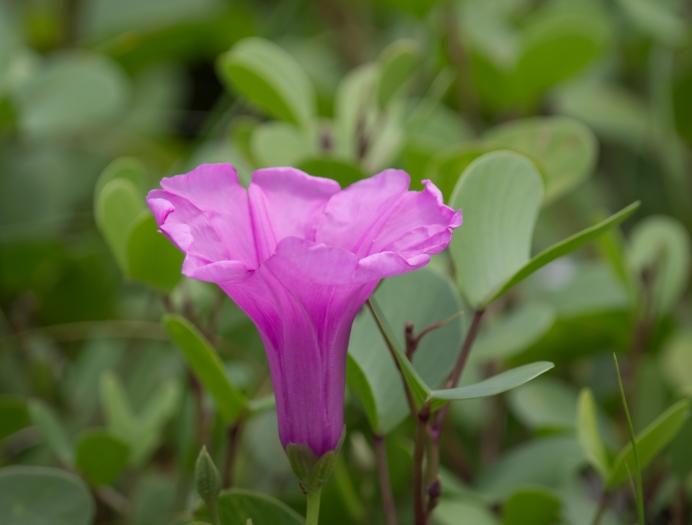Beach Morning Glory
(Ipomoea pes-caprae)
Beach Morning Glory (Ipomoea pes-caprae)
/
/

Drajay1976
CC BY-SA 3.0
Image By:
Drajay1976
Recorded By:
Copyright:
CC BY-SA 3.0
Copyright Notice:
Photo by: Drajay1976 | License Type: CC BY-SA 3.0 | License URL: https://creativecommons.org/licenses/by-sa/3.0 | Uploader: Drajay1976 | Publisher: Wikipedia Commons |











































































Estimated Native Range
Summary
Ipomoea pes-caprae, commonly known as Beach Morning Glory or Goat’s Foot, is an evergreen vine or herb native to coastal areas, including beaches, dunes, and coastal grasslands in the Tropical Americas, Southeast Asia, the Pacific Islands, and Tropical Africa. It is a prostrate perennial, often covering large areas with its long-trailing stems that can extend several meters in length, rooting at the nodes, and featuring a glabrous texture. The plant is characterized by its showy pink flowers with fused petals and a darker center, blooming throughout the year in warmer climates. The fruit is a capsule containing 4 hairy seeds that are adapted to float in water, aiding in dispersal.
Beach Morning Glory is crucial for dune stabilization, being one of the first plants to colonize sandy areas. It is typically found on the seaward slopes of dunes, where it sends long runners down towards the toe of the dune. This plant is valued in cultivation for its ability to stabilize soil and for its ornamental flowers. It thrives in full sun and requires medium amounts of water, preferring well-drained sandy soils. While it is not commonly used in traditional gardens, it is ideal for coastal restoration projects and erosion control.CC BY-SA 4.0
Beach Morning Glory is crucial for dune stabilization, being one of the first plants to colonize sandy areas. It is typically found on the seaward slopes of dunes, where it sends long runners down towards the toe of the dune. This plant is valued in cultivation for its ability to stabilize soil and for its ornamental flowers. It thrives in full sun and requires medium amounts of water, preferring well-drained sandy soils. While it is not commonly used in traditional gardens, it is ideal for coastal restoration projects and erosion control.CC BY-SA 4.0
Plant Description
- Plant Type: Vine
- Height: 30-75 feet
- Width: 0.3-0.8 feet
- Growth Rate: Moderate
- Flower Color: Purple
- Flowering Season: Spring, Summer
- Leaf Retention: Evergreen
Growth Requirements
- Sun: Full Sun
- Water: Medium
- Drainage: Fast, Medium
Common Uses
Bee Garden, Bird Garden, Butterfly Garden, Erosion Control, Hummingbird Garden, Low Maintenance, Salt Tolerant, Showy Flowers
Natural Habitat
Coastal areas, including beaches, dunes, and coastal grasslands
Other Names
Common Names: Bay-Hops, Bayhops, Goat’s Foot, Railroad Vine, Salsa, Salsa-Brava, Salsa-Pé-De-Cabra
Scientific Names: , Ipomoea pes-caprae, Bonanox orbiculata, Ipomoea brevipes, Ipomoea crassifolia, Ipomoea pes-caprae f. albiflora, Ipomoea pes-caprae f. arenaria, Plesiagopus cuneifolia, Plesiagopus maritima,
GBIF Accepted Name: Ipomoea pes-caprae (L.) R.Br.